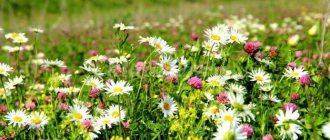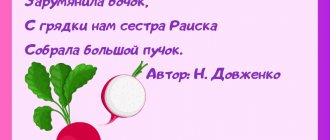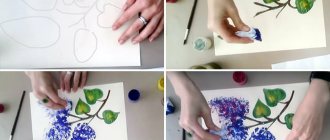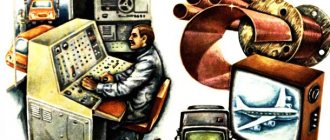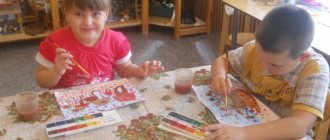Patriotic corner in kindergarten, brief description
A good help for the comprehensive implementation of the tasks of moral and patriotic education in kindergarten is a colorful, informative, patriotic corner in the group that attracts the attention of children. It can be designed, and then updated and supplemented with new materials together with preschoolers and their parents. According to the Federal State Educational Standard, the patriotic corner in a preschool institution should include six sections.
The main thematic blocks of the patriotic corner in kindergarten:
- “State” is the central block of the patriotic corner. Here in a prominent place are placed: a photograph of the President, images of the State Emblem, the State Flag, the text of the National Anthem, and a geographical map of the country.
- "Motherland". Illustrations of the natural and flora of Russia and the area in which children live. Symbols of the native land. Maps of the area. Photos of famous compatriots, heroes of the Great Patriotic War. Thematic folders introducing pupils to the achievements and glorious history of their native land.
- "Family traditions". Photos, children's drawings and applications dedicated to the theme of family, parents' work, joint family travel, traditions and holidays. Family trees of families depicted by children.
- "Folk Art and Culture". Dolls in national costumes. Models of peasant huts. Antique household items. Samples of folk art: artistic painting, embroidery, pottery and other folk crafts. Albums with photos and reproductions.
- "Small Motherland" Photos, postcards, posters depicting the streets of your hometown/town/village, kindergarten. Geographic map of the locality in which the students live. Drawings on the theme of labor, the beauty of the native nature, city holidays, and events significant for the native land. Portraits of fellow countrymen who glorified their small homeland.
- "Literature". Works of art, brochures, folders with visual materials on moral and patriotic themes.
Design options for patriotic corners in preschool educational institutions:
Lesson summary on the topic “I am a patriot”
Subject. I'm a patriot.
Target
: To form and expand students’ ideas about the concept of patriotism.
Tasks
:
Educational:
- To form and expand students’ ideas about the concept of patriotism.;
- To familiarize students with the concept of the Constitution, and the fundamental rights and responsibilities of a citizen of the Russian Federation;
- To form in students the concept of their native land, city, as a Small Motherland;
Educational:
- continue to develop in students the ability to analyze, highlight the main thing and objectively assess the surrounding reality.
Educational:
- developing in students a sense of patriotism for their small Motherland;
Type of lesson:
combined.
Basic concepts: Constitution, patriotism, patriot, citizen.
Equipment and materials:
set “computer + screen + projector”, pencils.
Lesson plan:
- Organizational moment (3-5 min.).
- Updating knowledge (7-10 min.).
- Explanation of new material (15 min.).
- Dynamic pauses (2-3 min.)
- Fixing the material (7-10 min.)
- Reflection. Summing up (5 min.)
Progress of the lesson
1. Organizational moment
Greeting students. Safety of the contingent. Checking whether everything is on students’ desks for work, checking those who are absent.
2. Updating knowledge:
Teacher.
I will say the beginning of the sentence, and you will finish it.
1. Our country is called…. (Russia)
;
2. Citizens of Russia are called…. (Russians)
;
3. Name the main city of Russia? (Moscow)
4. What is the name of the main square of the country? (Red Square)
Teacher.
A big Motherland always begins with a small one - your family, yard and home, kindergarten and school, forest and river.
Small Motherland is part of a big country.
5. What is the name of the region in which we live? (Khabarovsk region)
6. What is the name of our city? (Komsomolsk-on-Amur)
The city of Komsomolsk-on-Amur is our Little Motherland.
3. Explanation of new material.
Teacher.
Who is a citizen of his country? (This is a person who feels connected with a particular state, recognizes this state as his own, enjoys its protection, uses his civil rights and fulfills his civic duties).
— What country are you and I citizens of? (Russian Federation).
Teacher.
What do you know about the responsibilities of citizens? (pay taxes, obey laws...)
Teacher.
The fundamental law is the CONSTITUTION, translated from Latin as “structure”; it sets out the fundamentals of the structure of the state, the most important rules of human behavior and the relationship between the state and society. These rules remain constant and unchanged for a long time, and a citizen is obliged to know them. Our Constitution was adopted in 1993.
Teacher
. What laws do you know? (students' answers)
Teacher
. If there are duties that citizens must fulfill, then there are rights.
These are rights such as: the right to life, freedom, personal integrity, the right to inviolability of home, etc.
Teacher. What should we do if our civil rights are violated? (students' answers)
What are people called who violate the rights of other citizens? (bullies, criminals).
Our state protects us from them.
Teacher.
We talked about the state in which we live, but what is the Motherland? (children's answers).
Teacher.
Name words that are related, have the same root, to the word Motherland. (People, clan, relatives, relatives, nature.)
– These words have the same root. Which? (Genus.)
Exercise.
Add up and name the proverbs that you came up with about the Motherland:
| There is no more beautiful land | than our Motherland |
| A man without a homeland | what is a nightingale without a song |
| One person has one mother | he has one homeland |
Teacher.
Each country has distinctive signs. Name them. (Flag, coat of arms, anthem).
A person who loves his Motherland, honors its traditions, knows its history, the exploits and achievements of its people, who is ready to stand up for its defense, is called a patriot.
Patriotism
is a very powerful force. An example of this is the Great Patriotic War, in which people died, but were not allowed to capture their native land.
Being a patriot of his Motherland, a person must respect the love of other peoples for their Motherland and live in peace and harmony.
4. Dynamic pause
(see electronic appendix)
5. Fixing the material
Exercise.
Make a psychological portrait of a patriot
(mini essay)
.
Students are asked to describe what qualities they think a patriot should have.
6. Reflection.
Students are asked to briefly answer the questions presented.
| State the topic of the lesson in one word |
| Name the three main symbols of the country. |
| List words with similar roots to the word Motherland. |
| Explain the concept of Motherland |
| Name a person who loves, respects and is ready to defend his homeland. |
| Come up with three adjectives for the word patriot |
